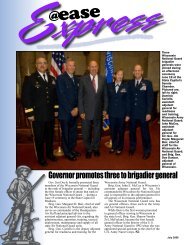At Ease - Wisconsin National Guard Department of Military Affairs
At Ease - Wisconsin National Guard Department of Military Affairs
At Ease - Wisconsin National Guard Department of Military Affairs
You also want an ePaper? Increase the reach of your titles
YUMPU automatically turns print PDFs into web optimized ePapers that Google loves.
And who’s going to pay for all this?<br />
Last fall the equipping working group began working<br />
through these questions with three states: Minnesota, which<br />
has a large Army <strong>Guard</strong> and combat units; Missouri, which has<br />
a medium-sized <strong>Guard</strong> presence; and Alabama, whose Army<br />
<strong>Guard</strong> is dominated by combat support and combat service<br />
support units.<br />
Experience with those three states will help set procedures<br />
for dealing with equipment flowing into the rest <strong>of</strong> the states and<br />
territories, Billman said.<br />
So what’s coming? Everything.<br />
Unmanned aerial vehicles; M-1 tanks with digital<br />
command and control suites; Win-T high-speed, high-capacity<br />
communications gear; the Army Battle Command System,<br />
Prophet battlefield electronics surveillance systems; digital<br />
topographic support systems for computerized terrain analysis<br />
and map-making.<br />
It’s not all about high technology, though.<br />
Army <strong>Guard</strong> units will also be receiving fire trucks, medium<br />
and heavy tactical vehicles, tactical trailers, armored security<br />
vehicles, helicopters, field hospitals, field kitchens, SINCGARS<br />
(Single Channel Ground and Airborne Radio System) radios,<br />
generators, M-4 rifles, pistols and more.<br />
Lt. Gen. H Steven Blum, who stepped down as chief <strong>of</strong> the<br />
<strong>National</strong> <strong>Guard</strong> Bureau in November, said the Army has to agree<br />
on 342 line items <strong>of</strong> equipment that the <strong>Guard</strong> will receive.<br />
The goal is to provide <strong>Guard</strong> units with at least 77 percent<br />
<strong>of</strong> their authorized equipment by 2013.<br />
That compares to the <strong>Guard</strong>’s 75-percent equipment level<br />
prior to the Sept. 11 terrorist attacks. Over the next seven years<br />
as more <strong>Guard</strong> units went to war in Afghanistan and Iraq,<br />
equipment levels fell dramatically, leaving some states with as<br />
little as 40 percent <strong>of</strong> their required gear.<br />
Ultimately, the <strong>Guard</strong> hopes to equip its units to 100 percent<br />
<strong>of</strong> authorized levels, and the Army has agreed to that goal,<br />
said Col. Michael Fortune, the Army <strong>Guard</strong>’s chief <strong>of</strong> materiel<br />
operations at the <strong>Guard</strong> Bureau.<br />
But reaching 100 percent won’t be easy. “Requirements<br />
continue to grow, equipment becomes obsolete, there will be<br />
battle losses and damage,” Fortune said. In addition, the <strong>Guard</strong><br />
is likely to have to leave some equipment behind in Iraq as U.S.<br />
forces withdraw in 2009, 2010 and possibly later.<br />
“So even though we’ll have all this money pouring in,<br />
we’ll still be fighting a battle” to ensure that equipment arrivals<br />
outpace losses, Fortune said.<br />
Maj. Jim Jones, a member <strong>of</strong> <strong>Guard</strong> Bureau’s equipping<br />
working group, said the plan is to have all maneuver brigade<br />
combat teams fully equipped by 2015 and all support brigades<br />
fully equipped by 2019.<br />
But even Blum’s vision <strong>of</strong> an Army <strong>Guard</strong> with 77 percent<br />
<strong>of</strong> its authorized equipment by 2013 would be an enormous<br />
improvement.<br />
In early 2007, Blum warned the House Armed Services<br />
Committee that some states had as little as 40 percent <strong>of</strong> the<br />
equipment needed to respond to domestic emergencies and 49<br />
percent <strong>of</strong> what was required for war.<br />
A year later the picture had improved substantially.<br />
In April 2008 Blum testified to Congress that <strong>Guard</strong> units<br />
on average had 61 percent <strong>of</strong> the equipment they needed, and<br />
would have about 65 percent by the end <strong>of</strong> the year.<br />
“Real, tangible money was authorized and appropriated,”<br />
explained Blum, who has since been assigned as deputy<br />
commander <strong>of</strong> the U.S. Northern Command.<br />
In 2005 the Army <strong>Guard</strong> received just $1.7 billion for<br />
equipment. In 2006 that sum jumped to $4.1 billion. By 2007 it<br />
was $7 billion. Funding for 2008 dropped back to $4.2 billion<br />
in the regular defense budget, but at least $2.7 billion more for<br />
March 2009 43





